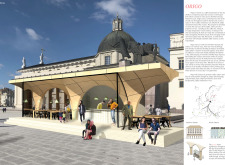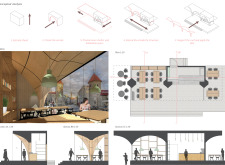5 key facts about this project
At its core, this project represents not only a physical structure but a vision for contemporary living that prioritizes sustainability and community engagement. The design reflects an understanding of how space can influence human interaction, with open and inviting areas that encourage social gatherings and collaborative activities. This emphasis on community functions transforms the space into more than just an architectural entity, positioning it as a vital hub for various activities, from recreational events to educational workshops.
Key components of the design include diverse gathering spaces that cater to varying group sizes. These areas are intentionally designed with flexibility in mind, allowing for multiple configurations to accommodate different events and uses. Large windows throughout the structure flood the interiors with natural light, fostering a warm atmosphere and blurring the lines between indoor and outdoor spaces. This integration not only enhances user experience but also reduces reliance on artificial lighting, aligning with environmentally friendly practices.
The project’s materiality plays a crucial role in achieving its objectives. A careful selection of materials, including concrete, wood, and glass, informs both structural integrity and aesthetic appeal. Concrete provides a durable foundation, while wood adds warmth and texture, establishing a welcoming ambiance. Glass elements are employed strategically to allow for transparency, inviting the outside in and creating visual connections to the landscape. This combination of materials reflects a commitment to sustainability while also aiming to create a harmonious dialogue between the building and its environment.
Unique design approaches emerge through the articulation of its form. The roofline, characterized by gentle undulations, not only serves an aesthetic purpose but also helps manage rainwater runoff effectively. Green roofs and terraces are incorporated into the design as well, acting as additional communal spaces while promoting biodiversity. These features showcase an innovative approach to integrating nature within urban settings, enhancing the ecological value of the project.
The building’s façade is carefully crafted to respond to the local climate, enhancing energy efficiency while ensuring comfort for its occupants. By employing overhangs and sun shading devices, the design naturally mitigates heat gain during warmer months, reducing the need for mechanical cooling systems. This aspect of the design reinforces the project’s commitment to sustainability and highlights its role as a model for future architectural endeavors.
Furthermore, the project embraces local culture, drawing inspiration from regional architectural styles and materials. This thoughtful integration not only pays homage to the heritage of the area but also ensures that the building resonates with the community it serves, fostering a sense of pride among its users. By reflecting local identity in its design choices, the project becomes more than a mere structure; it transforms into a living part of its context.
As you explore the project presentation, additional insights can be gleaned from reviewing the architectural plans and sections that provide a more comprehensive understanding of its layout and design intricacies. Engaging with these architectural elements will enrich the appreciation of the thoughtful decisions that guided the design process. The unique features and design ideals reflected in this project signify a forward-thinking approach to architecture, aimed at enhancing the quality of life for its community. Dive deeper into the architectural designs and ideas that make this project a noteworthy example of contemporary architecture, fostering a dialogue between environment, function, and community.


























